Transference Issues in Addiction and Treatment
VerifiedAdded on 2023/03/31
|12
|2922
|60
AI Summary
This article explores the phenomenon of transference in addiction and treatment. It discusses Freud's theory of transference, different types of transference, and how to identify and deal with transference in therapy. The article provides valuable insights for therapists and individuals undergoing therapy.
Contribute Materials
Your contribution can guide someone’s learning journey. Share your
documents today.
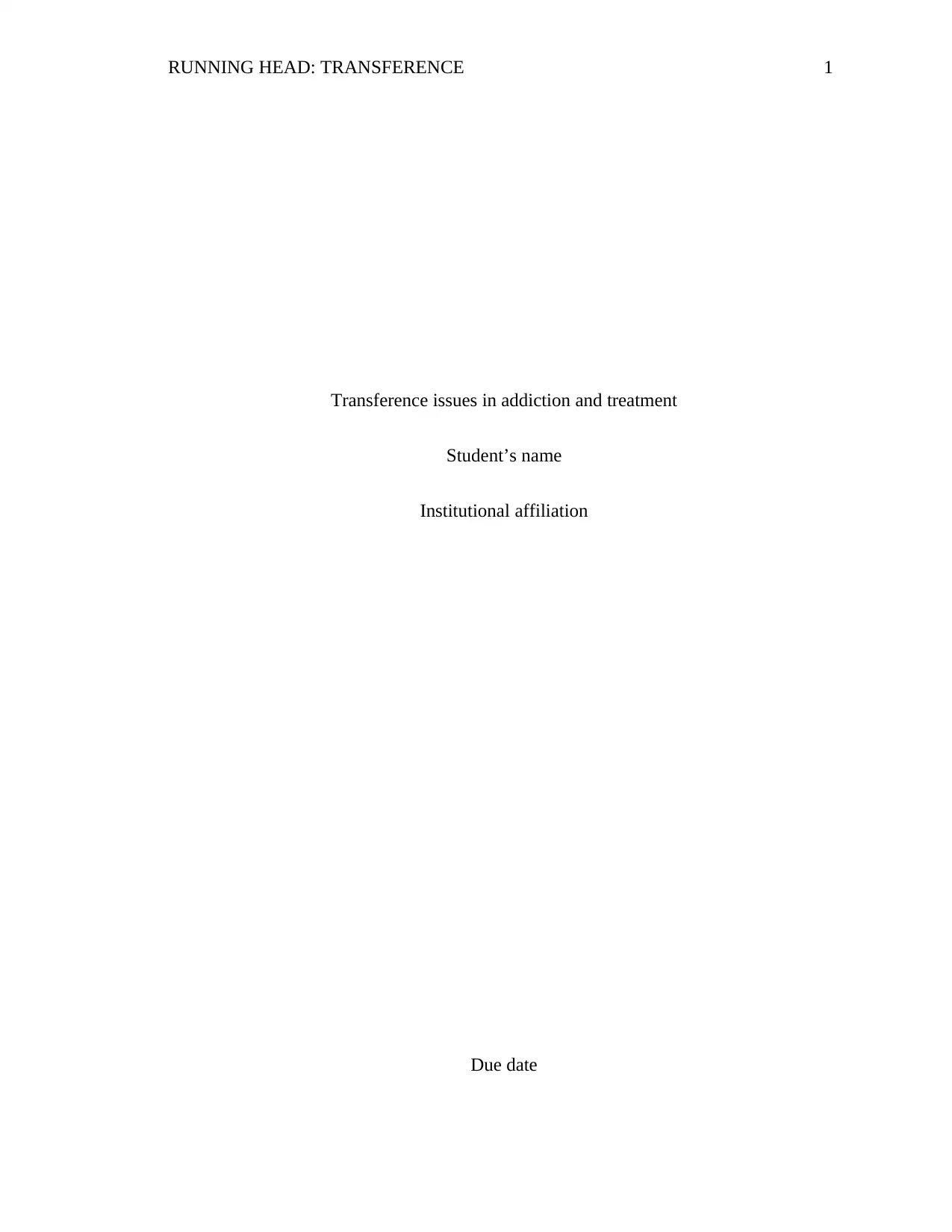
RUNNING HEAD: TRANSFERENCE 1
Transference issues in addiction and treatment
Student’s name
Institutional affiliation
Due date
Transference issues in addiction and treatment
Student’s name
Institutional affiliation
Due date
Secure Best Marks with AI Grader
Need help grading? Try our AI Grader for instant feedback on your assignments.

Transference 2
Introduction
Transference can be described as a psychological phenomenon whereby someone’s
feelings and expectations are directed and applied to another person. Transference is mostly used
in therapeutic relationships to refer to a situation whereby a client who is undergoing therapy
attaches and transfers feelings and attitudes learned from an earlier life towards the counselor or
the therapist (Tsiantis, 2018). In most cases, transference occurs unconsciously whereby the
client begins seeing the therapist as another person most likely a parent or someone who they
have had an earlier interaction. This influences the feelings and attitudes of the client and their
expectations of the therapist as they begin to see the therapist as the other person. This paper
focuses on transference issues in addiction and treatment.
Freud’s theory of Libido and Theory of Transference
Sigmund Freud, an Austrian neurologist is well known for his famous works on the
psychoanalytic theory of personality. Freud is also known for his contribution to counseling and
psychotherapy such as the work on the dynamics of transference among other works. In the
psychoanalytic theory, Sigmund Freud focuses on the sex drives also known as libido as the
source of life instincts and as the forces that guides growths as well as shaping personality
(Hersh, Caligor, & Yeomans, 2017).
In the psychoanalytic theory, Freud argues that development of personality takes place in
distinct stages. In each of these stages, there are different sex drives or libido which must be
satisfied with care. Failure to satisfy the libido at each stage leads to fixations while excessive
attention towards the libido leads to a distorted personality explains Klein, (2017). According to
Freud therefore, the parents or the immediate care givers are supposed to control the extent to
Introduction
Transference can be described as a psychological phenomenon whereby someone’s
feelings and expectations are directed and applied to another person. Transference is mostly used
in therapeutic relationships to refer to a situation whereby a client who is undergoing therapy
attaches and transfers feelings and attitudes learned from an earlier life towards the counselor or
the therapist (Tsiantis, 2018). In most cases, transference occurs unconsciously whereby the
client begins seeing the therapist as another person most likely a parent or someone who they
have had an earlier interaction. This influences the feelings and attitudes of the client and their
expectations of the therapist as they begin to see the therapist as the other person. This paper
focuses on transference issues in addiction and treatment.
Freud’s theory of Libido and Theory of Transference
Sigmund Freud, an Austrian neurologist is well known for his famous works on the
psychoanalytic theory of personality. Freud is also known for his contribution to counseling and
psychotherapy such as the work on the dynamics of transference among other works. In the
psychoanalytic theory, Sigmund Freud focuses on the sex drives also known as libido as the
source of life instincts and as the forces that guides growths as well as shaping personality
(Hersh, Caligor, & Yeomans, 2017).
In the psychoanalytic theory, Freud argues that development of personality takes place in
distinct stages. In each of these stages, there are different sex drives or libido which must be
satisfied with care. Failure to satisfy the libido at each stage leads to fixations while excessive
attention towards the libido leads to a distorted personality explains Klein, (2017). According to
Freud therefore, the parents or the immediate care givers are supposed to control the extent to
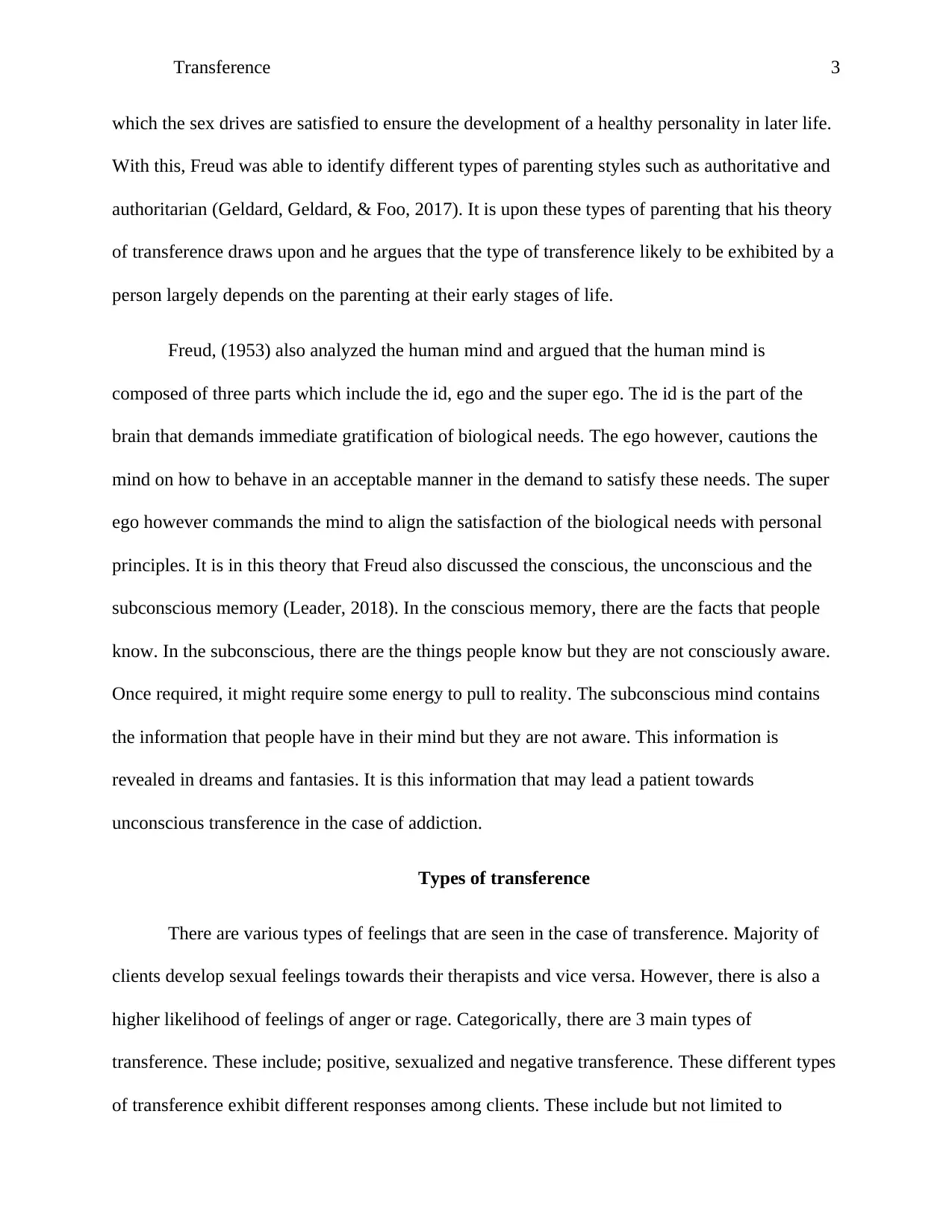
Transference 3
which the sex drives are satisfied to ensure the development of a healthy personality in later life.
With this, Freud was able to identify different types of parenting styles such as authoritative and
authoritarian (Geldard, Geldard, & Foo, 2017). It is upon these types of parenting that his theory
of transference draws upon and he argues that the type of transference likely to be exhibited by a
person largely depends on the parenting at their early stages of life.
Freud, (1953) also analyzed the human mind and argued that the human mind is
composed of three parts which include the id, ego and the super ego. The id is the part of the
brain that demands immediate gratification of biological needs. The ego however, cautions the
mind on how to behave in an acceptable manner in the demand to satisfy these needs. The super
ego however commands the mind to align the satisfaction of the biological needs with personal
principles. It is in this theory that Freud also discussed the conscious, the unconscious and the
subconscious memory (Leader, 2018). In the conscious memory, there are the facts that people
know. In the subconscious, there are the things people know but they are not consciously aware.
Once required, it might require some energy to pull to reality. The subconscious mind contains
the information that people have in their mind but they are not aware. This information is
revealed in dreams and fantasies. It is this information that may lead a patient towards
unconscious transference in the case of addiction.
Types of transference
There are various types of feelings that are seen in the case of transference. Majority of
clients develop sexual feelings towards their therapists and vice versa. However, there is also a
higher likelihood of feelings of anger or rage. Categorically, there are 3 main types of
transference. These include; positive, sexualized and negative transference. These different types
of transference exhibit different responses among clients. These include but not limited to
which the sex drives are satisfied to ensure the development of a healthy personality in later life.
With this, Freud was able to identify different types of parenting styles such as authoritative and
authoritarian (Geldard, Geldard, & Foo, 2017). It is upon these types of parenting that his theory
of transference draws upon and he argues that the type of transference likely to be exhibited by a
person largely depends on the parenting at their early stages of life.
Freud, (1953) also analyzed the human mind and argued that the human mind is
composed of three parts which include the id, ego and the super ego. The id is the part of the
brain that demands immediate gratification of biological needs. The ego however, cautions the
mind on how to behave in an acceptable manner in the demand to satisfy these needs. The super
ego however commands the mind to align the satisfaction of the biological needs with personal
principles. It is in this theory that Freud also discussed the conscious, the unconscious and the
subconscious memory (Leader, 2018). In the conscious memory, there are the facts that people
know. In the subconscious, there are the things people know but they are not consciously aware.
Once required, it might require some energy to pull to reality. The subconscious mind contains
the information that people have in their mind but they are not aware. This information is
revealed in dreams and fantasies. It is this information that may lead a patient towards
unconscious transference in the case of addiction.
Types of transference
There are various types of feelings that are seen in the case of transference. Majority of
clients develop sexual feelings towards their therapists and vice versa. However, there is also a
higher likelihood of feelings of anger or rage. Categorically, there are 3 main types of
transference. These include; positive, sexualized and negative transference. These different types
of transference exhibit different responses among clients. These include but not limited to
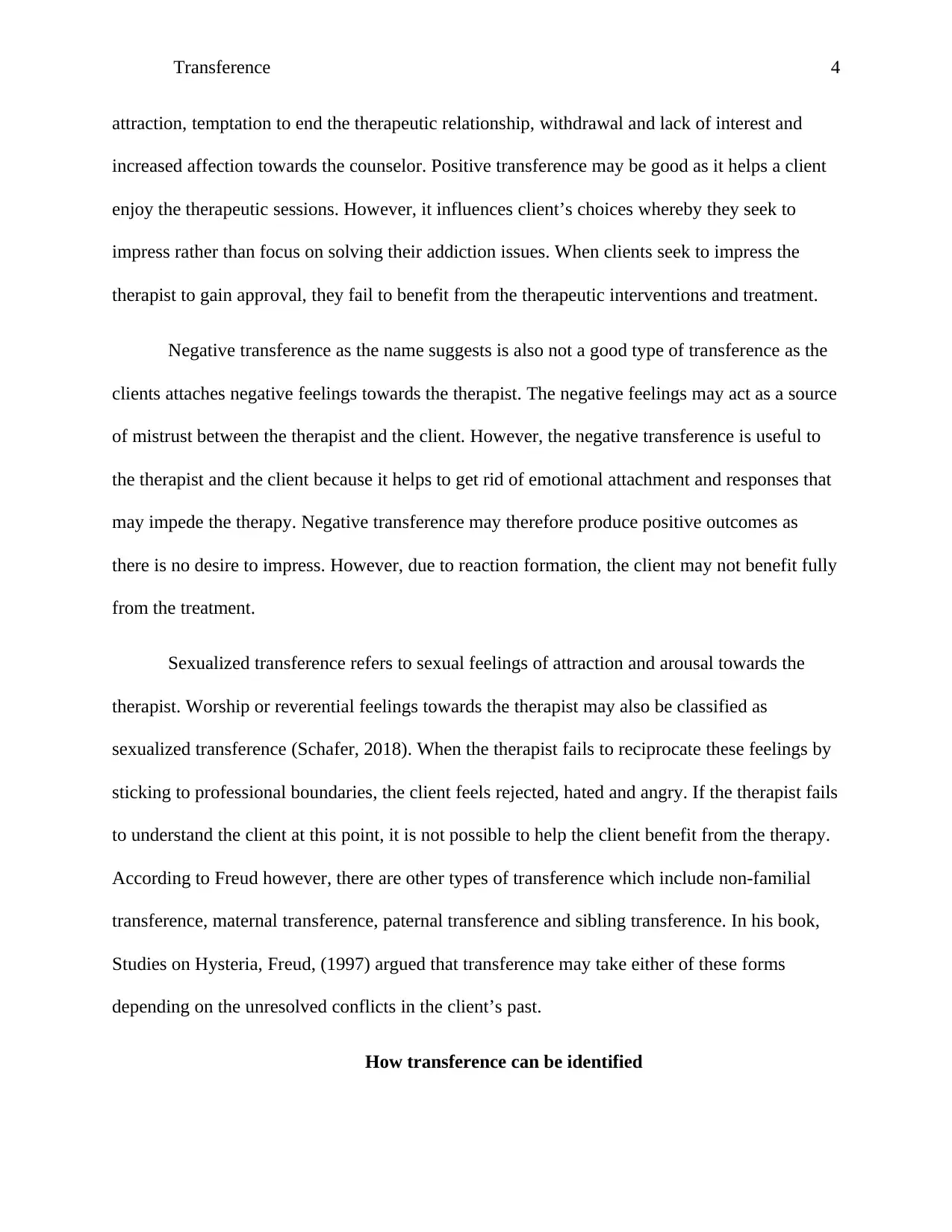
Transference 4
attraction, temptation to end the therapeutic relationship, withdrawal and lack of interest and
increased affection towards the counselor. Positive transference may be good as it helps a client
enjoy the therapeutic sessions. However, it influences client’s choices whereby they seek to
impress rather than focus on solving their addiction issues. When clients seek to impress the
therapist to gain approval, they fail to benefit from the therapeutic interventions and treatment.
Negative transference as the name suggests is also not a good type of transference as the
clients attaches negative feelings towards the therapist. The negative feelings may act as a source
of mistrust between the therapist and the client. However, the negative transference is useful to
the therapist and the client because it helps to get rid of emotional attachment and responses that
may impede the therapy. Negative transference may therefore produce positive outcomes as
there is no desire to impress. However, due to reaction formation, the client may not benefit fully
from the treatment.
Sexualized transference refers to sexual feelings of attraction and arousal towards the
therapist. Worship or reverential feelings towards the therapist may also be classified as
sexualized transference (Schafer, 2018). When the therapist fails to reciprocate these feelings by
sticking to professional boundaries, the client feels rejected, hated and angry. If the therapist fails
to understand the client at this point, it is not possible to help the client benefit from the therapy.
According to Freud however, there are other types of transference which include non-familial
transference, maternal transference, paternal transference and sibling transference. In his book,
Studies on Hysteria, Freud, (1997) argued that transference may take either of these forms
depending on the unresolved conflicts in the client’s past.
How transference can be identified
attraction, temptation to end the therapeutic relationship, withdrawal and lack of interest and
increased affection towards the counselor. Positive transference may be good as it helps a client
enjoy the therapeutic sessions. However, it influences client’s choices whereby they seek to
impress rather than focus on solving their addiction issues. When clients seek to impress the
therapist to gain approval, they fail to benefit from the therapeutic interventions and treatment.
Negative transference as the name suggests is also not a good type of transference as the
clients attaches negative feelings towards the therapist. The negative feelings may act as a source
of mistrust between the therapist and the client. However, the negative transference is useful to
the therapist and the client because it helps to get rid of emotional attachment and responses that
may impede the therapy. Negative transference may therefore produce positive outcomes as
there is no desire to impress. However, due to reaction formation, the client may not benefit fully
from the treatment.
Sexualized transference refers to sexual feelings of attraction and arousal towards the
therapist. Worship or reverential feelings towards the therapist may also be classified as
sexualized transference (Schafer, 2018). When the therapist fails to reciprocate these feelings by
sticking to professional boundaries, the client feels rejected, hated and angry. If the therapist fails
to understand the client at this point, it is not possible to help the client benefit from the therapy.
According to Freud however, there are other types of transference which include non-familial
transference, maternal transference, paternal transference and sibling transference. In his book,
Studies on Hysteria, Freud, (1997) argued that transference may take either of these forms
depending on the unresolved conflicts in the client’s past.
How transference can be identified
Secure Best Marks with AI Grader
Need help grading? Try our AI Grader for instant feedback on your assignments.
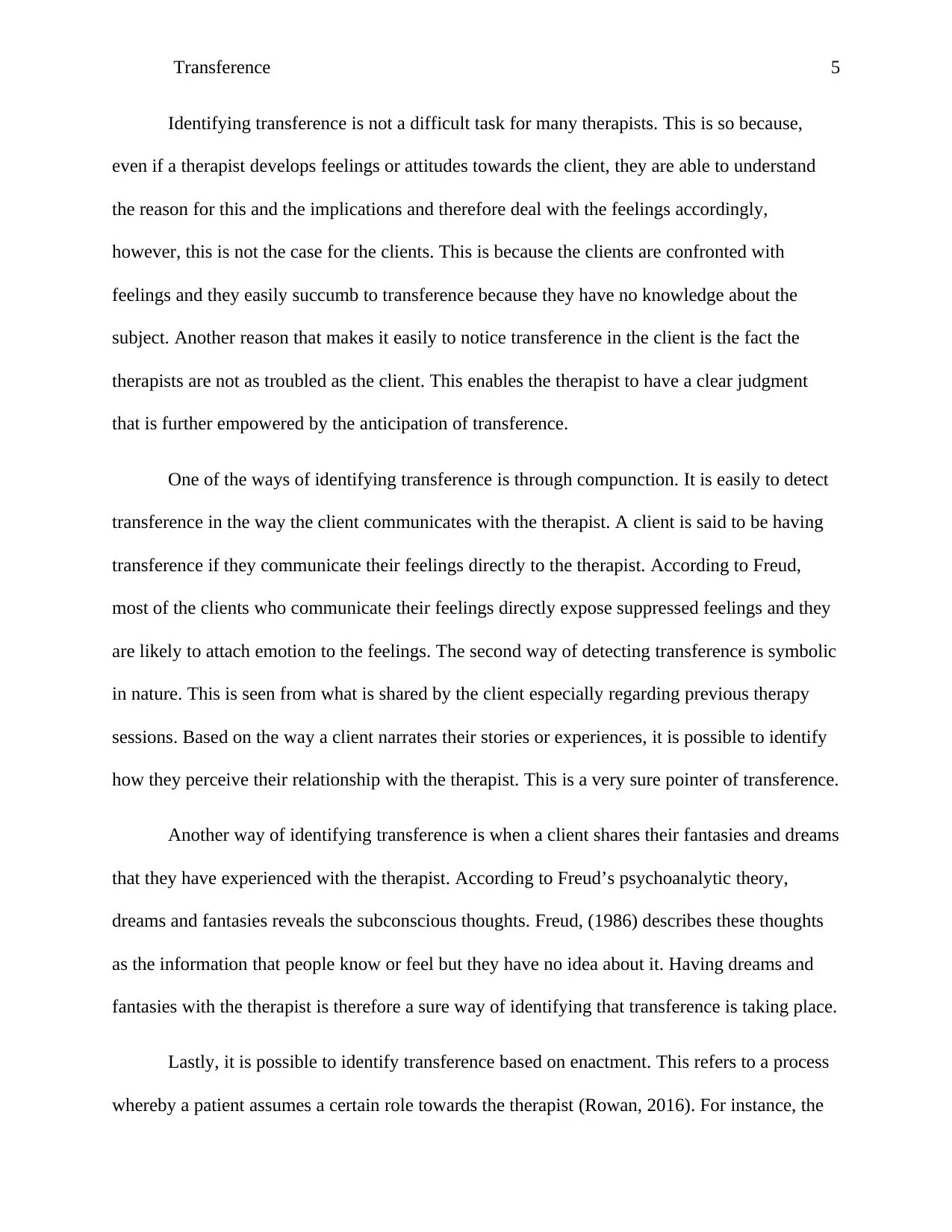
Transference 5
Identifying transference is not a difficult task for many therapists. This is so because,
even if a therapist develops feelings or attitudes towards the client, they are able to understand
the reason for this and the implications and therefore deal with the feelings accordingly,
however, this is not the case for the clients. This is because the clients are confronted with
feelings and they easily succumb to transference because they have no knowledge about the
subject. Another reason that makes it easily to notice transference in the client is the fact the
therapists are not as troubled as the client. This enables the therapist to have a clear judgment
that is further empowered by the anticipation of transference.
One of the ways of identifying transference is through compunction. It is easily to detect
transference in the way the client communicates with the therapist. A client is said to be having
transference if they communicate their feelings directly to the therapist. According to Freud,
most of the clients who communicate their feelings directly expose suppressed feelings and they
are likely to attach emotion to the feelings. The second way of detecting transference is symbolic
in nature. This is seen from what is shared by the client especially regarding previous therapy
sessions. Based on the way a client narrates their stories or experiences, it is possible to identify
how they perceive their relationship with the therapist. This is a very sure pointer of transference.
Another way of identifying transference is when a client shares their fantasies and dreams
that they have experienced with the therapist. According to Freud’s psychoanalytic theory,
dreams and fantasies reveals the subconscious thoughts. Freud, (1986) describes these thoughts
as the information that people know or feel but they have no idea about it. Having dreams and
fantasies with the therapist is therefore a sure way of identifying that transference is taking place.
Lastly, it is possible to identify transference based on enactment. This refers to a process
whereby a patient assumes a certain role towards the therapist (Rowan, 2016). For instance, the
Identifying transference is not a difficult task for many therapists. This is so because,
even if a therapist develops feelings or attitudes towards the client, they are able to understand
the reason for this and the implications and therefore deal with the feelings accordingly,
however, this is not the case for the clients. This is because the clients are confronted with
feelings and they easily succumb to transference because they have no knowledge about the
subject. Another reason that makes it easily to notice transference in the client is the fact the
therapists are not as troubled as the client. This enables the therapist to have a clear judgment
that is further empowered by the anticipation of transference.
One of the ways of identifying transference is through compunction. It is easily to detect
transference in the way the client communicates with the therapist. A client is said to be having
transference if they communicate their feelings directly to the therapist. According to Freud,
most of the clients who communicate their feelings directly expose suppressed feelings and they
are likely to attach emotion to the feelings. The second way of detecting transference is symbolic
in nature. This is seen from what is shared by the client especially regarding previous therapy
sessions. Based on the way a client narrates their stories or experiences, it is possible to identify
how they perceive their relationship with the therapist. This is a very sure pointer of transference.
Another way of identifying transference is when a client shares their fantasies and dreams
that they have experienced with the therapist. According to Freud’s psychoanalytic theory,
dreams and fantasies reveals the subconscious thoughts. Freud, (1986) describes these thoughts
as the information that people know or feel but they have no idea about it. Having dreams and
fantasies with the therapist is therefore a sure way of identifying that transference is taking place.
Lastly, it is possible to identify transference based on enactment. This refers to a process
whereby a patient assumes a certain role towards the therapist (Rowan, 2016). For instance, the

Transference 6
patient may assume the role of a child where they expect to get motivation, support and care
from the therapist as if the therapist wad their parent. In this case, the patient may continue to
become overly dependent on the therapist even on matters beyond the therapeutic relationship. If
this happens, it is then sure to conclude that transference is taking place unconsciously.
Transference and counter transference
A therapist ought to maintain high professional standards and they should also be quick
to identify and deal with transference to also avoid identifying with their clients and also having
feelings towards them, a situation known as counter transference (Kernberg, 2016).
Countertransference is believed to arise from the perception as well as how they understand their
clients. Based on their past experience, counselors may also try to understand clients by using
other people and trying to see the client in another person that they have encountered in their life.
According to Parth, Datz, Seidman, & Löffler-Stastka, (2017) transference and
countertransference are therefore understood together since they arise from the communication
patterns, imaginations and fantasies that exist between the client and the therapist in therapeutic
and treatment sessions. According to Freud’s theory of transference, Freud argues that
transference occurs easily when the therapist is in a state of a blank slate or rather, when the
therapist does very little in the interaction. Therefore Freud, (1958) considered transference as
natural which differs with the explanation of Jung.
According to Jung, (1913), transference and counter transference depends much more on
the dialectic process and the therapeutic relationship therefore concluding that both the therapist
and the client are equally involved. Treatment is therefore a mutual influence between the client
patient may assume the role of a child where they expect to get motivation, support and care
from the therapist as if the therapist wad their parent. In this case, the patient may continue to
become overly dependent on the therapist even on matters beyond the therapeutic relationship. If
this happens, it is then sure to conclude that transference is taking place unconsciously.
Transference and counter transference
A therapist ought to maintain high professional standards and they should also be quick
to identify and deal with transference to also avoid identifying with their clients and also having
feelings towards them, a situation known as counter transference (Kernberg, 2016).
Countertransference is believed to arise from the perception as well as how they understand their
clients. Based on their past experience, counselors may also try to understand clients by using
other people and trying to see the client in another person that they have encountered in their life.
According to Parth, Datz, Seidman, & Löffler-Stastka, (2017) transference and
countertransference are therefore understood together since they arise from the communication
patterns, imaginations and fantasies that exist between the client and the therapist in therapeutic
and treatment sessions. According to Freud’s theory of transference, Freud argues that
transference occurs easily when the therapist is in a state of a blank slate or rather, when the
therapist does very little in the interaction. Therefore Freud, (1958) considered transference as
natural which differs with the explanation of Jung.
According to Jung, (1913), transference and counter transference depends much more on
the dialectic process and the therapeutic relationship therefore concluding that both the therapist
and the client are equally involved. Treatment is therefore a mutual influence between the client
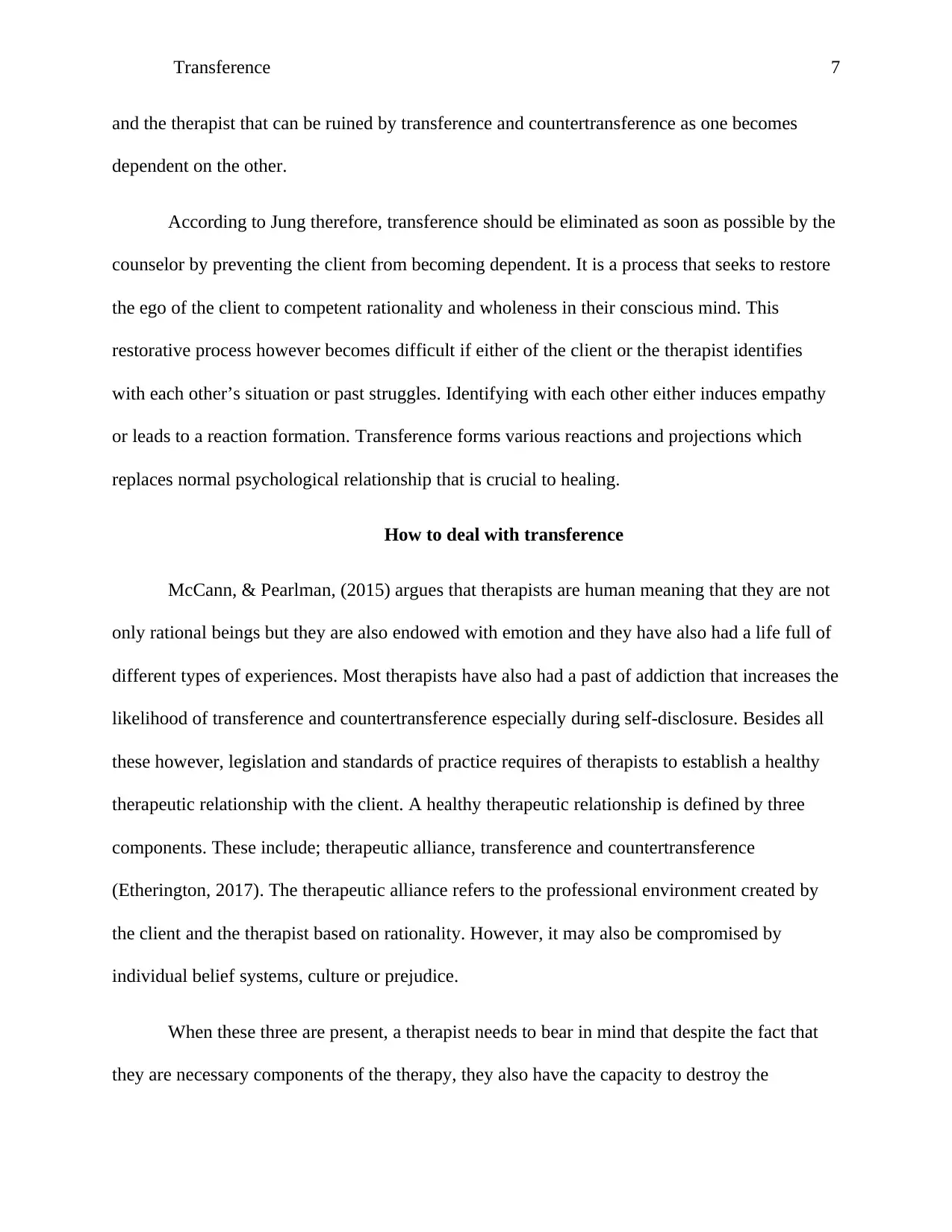
Transference 7
and the therapist that can be ruined by transference and countertransference as one becomes
dependent on the other.
According to Jung therefore, transference should be eliminated as soon as possible by the
counselor by preventing the client from becoming dependent. It is a process that seeks to restore
the ego of the client to competent rationality and wholeness in their conscious mind. This
restorative process however becomes difficult if either of the client or the therapist identifies
with each other’s situation or past struggles. Identifying with each other either induces empathy
or leads to a reaction formation. Transference forms various reactions and projections which
replaces normal psychological relationship that is crucial to healing.
How to deal with transference
McCann, & Pearlman, (2015) argues that therapists are human meaning that they are not
only rational beings but they are also endowed with emotion and they have also had a life full of
different types of experiences. Most therapists have also had a past of addiction that increases the
likelihood of transference and countertransference especially during self-disclosure. Besides all
these however, legislation and standards of practice requires of therapists to establish a healthy
therapeutic relationship with the client. A healthy therapeutic relationship is defined by three
components. These include; therapeutic alliance, transference and countertransference
(Etherington, 2017). The therapeutic alliance refers to the professional environment created by
the client and the therapist based on rationality. However, it may also be compromised by
individual belief systems, culture or prejudice.
When these three are present, a therapist needs to bear in mind that despite the fact that
they are necessary components of the therapy, they also have the capacity to destroy the
and the therapist that can be ruined by transference and countertransference as one becomes
dependent on the other.
According to Jung therefore, transference should be eliminated as soon as possible by the
counselor by preventing the client from becoming dependent. It is a process that seeks to restore
the ego of the client to competent rationality and wholeness in their conscious mind. This
restorative process however becomes difficult if either of the client or the therapist identifies
with each other’s situation or past struggles. Identifying with each other either induces empathy
or leads to a reaction formation. Transference forms various reactions and projections which
replaces normal psychological relationship that is crucial to healing.
How to deal with transference
McCann, & Pearlman, (2015) argues that therapists are human meaning that they are not
only rational beings but they are also endowed with emotion and they have also had a life full of
different types of experiences. Most therapists have also had a past of addiction that increases the
likelihood of transference and countertransference especially during self-disclosure. Besides all
these however, legislation and standards of practice requires of therapists to establish a healthy
therapeutic relationship with the client. A healthy therapeutic relationship is defined by three
components. These include; therapeutic alliance, transference and countertransference
(Etherington, 2017). The therapeutic alliance refers to the professional environment created by
the client and the therapist based on rationality. However, it may also be compromised by
individual belief systems, culture or prejudice.
When these three are present, a therapist needs to bear in mind that despite the fact that
they are necessary components of the therapy, they also have the capacity to destroy the
Paraphrase This Document
Need a fresh take? Get an instant paraphrase of this document with our AI Paraphraser

Transference 8
relationship between the client and the therapist. Therefore, the therapist need to understand
ways of dealing with them to ensure that the therapy or treatment is not compromised. One of the
negative influences of transference is that when a client sees the therapist as someone they hate.
They are likely to hate the therapist with the same venom and attitude as that other person that
they hate. They are therefore unable to maintain objective neutrality. This may lead to
psychological responses towards therapy and most of the times the client may remain passive
and disinterested in the therapy. This may be equally difficult for a counselor who has some
dislike for the client. It becomes very difficult to understand, accept and confirm such people and
the therapist is unable to maintain the unconditional positive regard. Lack of UPR in the therapy
may make the therapist to have judgmental tendencies towards the client.
According to Eremie, & Ubolum, (2016) maintaining professionalism is one of the many
ways in which therapists can use to reduce or counter the effects of transference. Maintaining
professionalism is not always easy and in most cases it requires application of practical efforts.
These include; taking control of feelings, perceptions and attitudes, addressing the risks of
vicarious trauma, speaking with colleagues about one’s feelings and seeking advice from more
experienced therapists or counselor. Maintaining a high level of self-awareness, avoiding savior
behavior and setting professional boundaries.
Foulkes, (2018) argues that self-awareness demands that one gets to know about their
flaws, weaknesses biases and strengths. With these, it is more likely to offer meaningful help to
clients as one is able to set their defenses high. Another advantage of high levels of self-
awareness is that one is able to avoid areas that may lead to transference or counter transference.
Talking control of one’s feelings, perceptions, beliefs and attitudes helps one to maintain an
unconditional positive regard that helps one to treat people well irrespective of their bad behavior
relationship between the client and the therapist. Therefore, the therapist need to understand
ways of dealing with them to ensure that the therapy or treatment is not compromised. One of the
negative influences of transference is that when a client sees the therapist as someone they hate.
They are likely to hate the therapist with the same venom and attitude as that other person that
they hate. They are therefore unable to maintain objective neutrality. This may lead to
psychological responses towards therapy and most of the times the client may remain passive
and disinterested in the therapy. This may be equally difficult for a counselor who has some
dislike for the client. It becomes very difficult to understand, accept and confirm such people and
the therapist is unable to maintain the unconditional positive regard. Lack of UPR in the therapy
may make the therapist to have judgmental tendencies towards the client.
According to Eremie, & Ubolum, (2016) maintaining professionalism is one of the many
ways in which therapists can use to reduce or counter the effects of transference. Maintaining
professionalism is not always easy and in most cases it requires application of practical efforts.
These include; taking control of feelings, perceptions and attitudes, addressing the risks of
vicarious trauma, speaking with colleagues about one’s feelings and seeking advice from more
experienced therapists or counselor. Maintaining a high level of self-awareness, avoiding savior
behavior and setting professional boundaries.
Foulkes, (2018) argues that self-awareness demands that one gets to know about their
flaws, weaknesses biases and strengths. With these, it is more likely to offer meaningful help to
clients as one is able to set their defenses high. Another advantage of high levels of self-
awareness is that one is able to avoid areas that may lead to transference or counter transference.
Talking control of one’s feelings, perceptions, beliefs and attitudes helps one to maintain an
unconditional positive regard that helps one to treat people well irrespective of their bad behavior
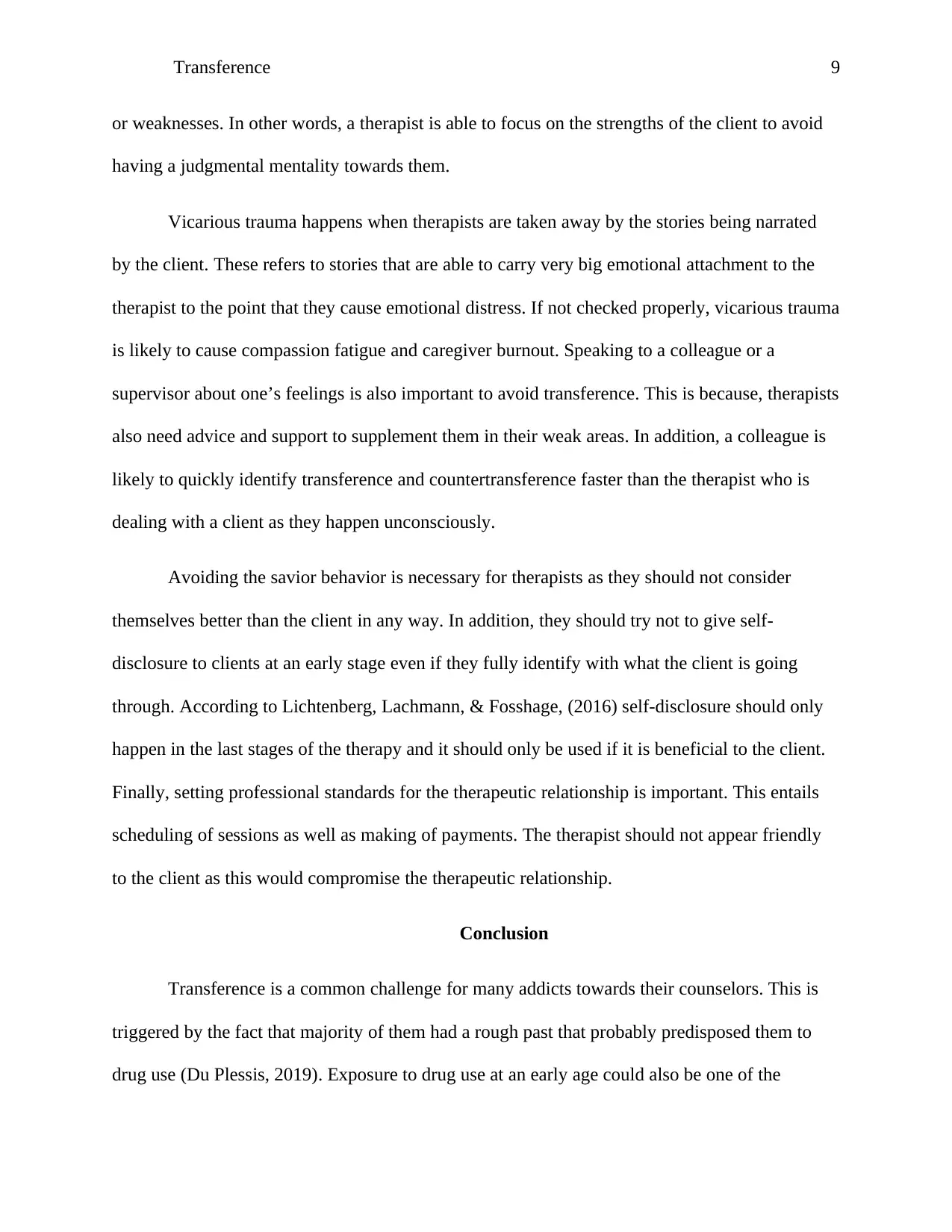
Transference 9
or weaknesses. In other words, a therapist is able to focus on the strengths of the client to avoid
having a judgmental mentality towards them.
Vicarious trauma happens when therapists are taken away by the stories being narrated
by the client. These refers to stories that are able to carry very big emotional attachment to the
therapist to the point that they cause emotional distress. If not checked properly, vicarious trauma
is likely to cause compassion fatigue and caregiver burnout. Speaking to a colleague or a
supervisor about one’s feelings is also important to avoid transference. This is because, therapists
also need advice and support to supplement them in their weak areas. In addition, a colleague is
likely to quickly identify transference and countertransference faster than the therapist who is
dealing with a client as they happen unconsciously.
Avoiding the savior behavior is necessary for therapists as they should not consider
themselves better than the client in any way. In addition, they should try not to give self-
disclosure to clients at an early stage even if they fully identify with what the client is going
through. According to Lichtenberg, Lachmann, & Fosshage, (2016) self-disclosure should only
happen in the last stages of the therapy and it should only be used if it is beneficial to the client.
Finally, setting professional standards for the therapeutic relationship is important. This entails
scheduling of sessions as well as making of payments. The therapist should not appear friendly
to the client as this would compromise the therapeutic relationship.
Conclusion
Transference is a common challenge for many addicts towards their counselors. This is
triggered by the fact that majority of them had a rough past that probably predisposed them to
drug use (Du Plessis, 2019). Exposure to drug use at an early age could also be one of the
or weaknesses. In other words, a therapist is able to focus on the strengths of the client to avoid
having a judgmental mentality towards them.
Vicarious trauma happens when therapists are taken away by the stories being narrated
by the client. These refers to stories that are able to carry very big emotional attachment to the
therapist to the point that they cause emotional distress. If not checked properly, vicarious trauma
is likely to cause compassion fatigue and caregiver burnout. Speaking to a colleague or a
supervisor about one’s feelings is also important to avoid transference. This is because, therapists
also need advice and support to supplement them in their weak areas. In addition, a colleague is
likely to quickly identify transference and countertransference faster than the therapist who is
dealing with a client as they happen unconsciously.
Avoiding the savior behavior is necessary for therapists as they should not consider
themselves better than the client in any way. In addition, they should try not to give self-
disclosure to clients at an early stage even if they fully identify with what the client is going
through. According to Lichtenberg, Lachmann, & Fosshage, (2016) self-disclosure should only
happen in the last stages of the therapy and it should only be used if it is beneficial to the client.
Finally, setting professional standards for the therapeutic relationship is important. This entails
scheduling of sessions as well as making of payments. The therapist should not appear friendly
to the client as this would compromise the therapeutic relationship.
Conclusion
Transference is a common challenge for many addicts towards their counselors. This is
triggered by the fact that majority of them had a rough past that probably predisposed them to
drug use (Du Plessis, 2019). Exposure to drug use at an early age could also be one of the

Transference
10
reasons that compel them to transference. In some cases however, the transference comes about
because of the therapist. In this case, most therapists have had a past of addiction and as they
give self-disclosure, it is likely that the client may develop feelings and attitudes towards them
resulting to transference.
10
reasons that compel them to transference. In some cases however, the transference comes about
because of the therapist. In this case, most therapists have had a past of addiction and as they
give self-disclosure, it is likely that the client may develop feelings and attitudes towards them
resulting to transference.
Secure Best Marks with AI Grader
Need help grading? Try our AI Grader for instant feedback on your assignments.

Transference
11
References
Du Plessis, G. (2019). An Existential Perspective on Addiction Treatment: A Logic-based
therapy case study.
Eremie, M., & Ubolum, W. (2016). Review of Psychoanalytic approach to Counselling. Int. J.
Innovative Psychology and Social Development, 4(2), 22-25.
Etherington, K. (2017). Personal experience and critical reflexivity in counselling and
psychotherapy research. Counselling and Psychotherapy Research, 17(2), 85-94.
Foulkes, S. H. (2018). My philosophy in psychotherapy. In Foundations of Group Analysis for
the Twenty-First Century(pp. 75-84). Routledge.
Freud, S. (1953). Three essays on the theory of sexuality (1905). In The Standard Edition of the
Complete Psychological Works of Sigmund Freud, Volume VII (1901-1905): A Case of
Hysteria, Three Essays on Sexuality and Other Works (pp. 123-246).
Freud, S. (1958). The dynamics of transference. In The standard edition of the complete
psychological works of Sigmund Freud, Volume XII (1911-1913): The case of Schreber,
papers on technique and other works (pp. 97-108).
Freud, S. (1986). Freud's discovery of psychoanalysis: The politics of hysteria. Ithaca: Cornell
University Press.
Freud, S. (1997). Dora: An analysis of a case of hysteria. Simon and Schuster.
Geldard, K., Geldard, D., & Foo, R. Y. (2017). Counselling children: A practical introduction.
Sage.
11
References
Du Plessis, G. (2019). An Existential Perspective on Addiction Treatment: A Logic-based
therapy case study.
Eremie, M., & Ubolum, W. (2016). Review of Psychoanalytic approach to Counselling. Int. J.
Innovative Psychology and Social Development, 4(2), 22-25.
Etherington, K. (2017). Personal experience and critical reflexivity in counselling and
psychotherapy research. Counselling and Psychotherapy Research, 17(2), 85-94.
Foulkes, S. H. (2018). My philosophy in psychotherapy. In Foundations of Group Analysis for
the Twenty-First Century(pp. 75-84). Routledge.
Freud, S. (1953). Three essays on the theory of sexuality (1905). In The Standard Edition of the
Complete Psychological Works of Sigmund Freud, Volume VII (1901-1905): A Case of
Hysteria, Three Essays on Sexuality and Other Works (pp. 123-246).
Freud, S. (1958). The dynamics of transference. In The standard edition of the complete
psychological works of Sigmund Freud, Volume XII (1911-1913): The case of Schreber,
papers on technique and other works (pp. 97-108).
Freud, S. (1986). Freud's discovery of psychoanalysis: The politics of hysteria. Ithaca: Cornell
University Press.
Freud, S. (1997). Dora: An analysis of a case of hysteria. Simon and Schuster.
Geldard, K., Geldard, D., & Foo, R. Y. (2017). Counselling children: A practical introduction.
Sage.
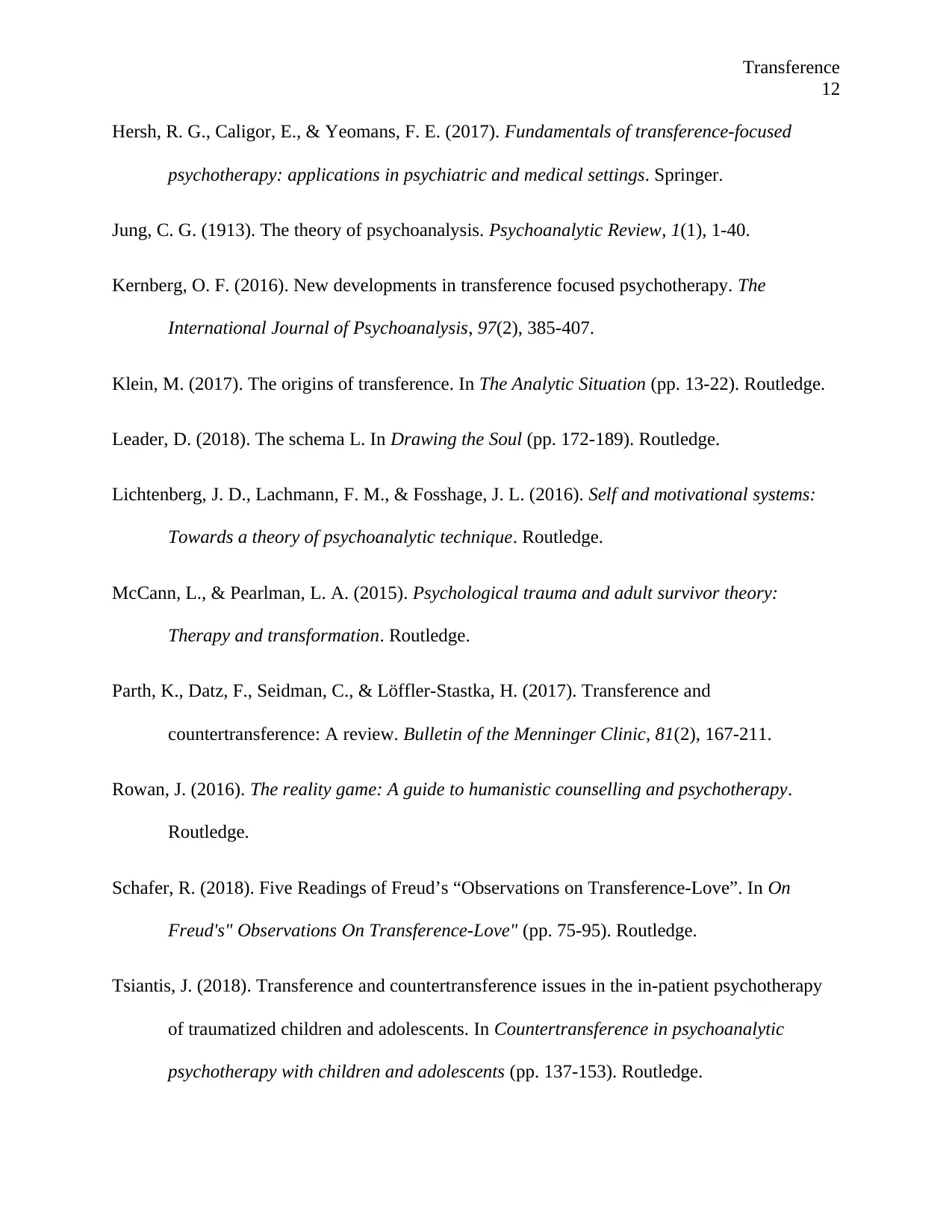
Transference
12
Hersh, R. G., Caligor, E., & Yeomans, F. E. (2017). Fundamentals of transference-focused
psychotherapy: applications in psychiatric and medical settings. Springer.
Jung, C. G. (1913). The theory of psychoanalysis. Psychoanalytic Review, 1(1), 1-40.
Kernberg, O. F. (2016). New developments in transference focused psychotherapy. The
International Journal of Psychoanalysis, 97(2), 385-407.
Klein, M. (2017). The origins of transference. In The Analytic Situation (pp. 13-22). Routledge.
Leader, D. (2018). The schema L. In Drawing the Soul (pp. 172-189). Routledge.
Lichtenberg, J. D., Lachmann, F. M., & Fosshage, J. L. (2016). Self and motivational systems:
Towards a theory of psychoanalytic technique. Routledge.
McCann, L., & Pearlman, L. A. (2015). Psychological trauma and adult survivor theory:
Therapy and transformation. Routledge.
Parth, K., Datz, F., Seidman, C., & Löffler-Stastka, H. (2017). Transference and
countertransference: A review. Bulletin of the Menninger Clinic, 81(2), 167-211.
Rowan, J. (2016). The reality game: A guide to humanistic counselling and psychotherapy.
Routledge.
Schafer, R. (2018). Five Readings of Freud’s “Observations on Transference-Love”. In On
Freud's" Observations On Transference-Love" (pp. 75-95). Routledge.
Tsiantis, J. (2018). Transference and countertransference issues in the in-patient psychotherapy
of traumatized children and adolescents. In Countertransference in psychoanalytic
psychotherapy with children and adolescents (pp. 137-153). Routledge.
12
Hersh, R. G., Caligor, E., & Yeomans, F. E. (2017). Fundamentals of transference-focused
psychotherapy: applications in psychiatric and medical settings. Springer.
Jung, C. G. (1913). The theory of psychoanalysis. Psychoanalytic Review, 1(1), 1-40.
Kernberg, O. F. (2016). New developments in transference focused psychotherapy. The
International Journal of Psychoanalysis, 97(2), 385-407.
Klein, M. (2017). The origins of transference. In The Analytic Situation (pp. 13-22). Routledge.
Leader, D. (2018). The schema L. In Drawing the Soul (pp. 172-189). Routledge.
Lichtenberg, J. D., Lachmann, F. M., & Fosshage, J. L. (2016). Self and motivational systems:
Towards a theory of psychoanalytic technique. Routledge.
McCann, L., & Pearlman, L. A. (2015). Psychological trauma and adult survivor theory:
Therapy and transformation. Routledge.
Parth, K., Datz, F., Seidman, C., & Löffler-Stastka, H. (2017). Transference and
countertransference: A review. Bulletin of the Menninger Clinic, 81(2), 167-211.
Rowan, J. (2016). The reality game: A guide to humanistic counselling and psychotherapy.
Routledge.
Schafer, R. (2018). Five Readings of Freud’s “Observations on Transference-Love”. In On
Freud's" Observations On Transference-Love" (pp. 75-95). Routledge.
Tsiantis, J. (2018). Transference and countertransference issues in the in-patient psychotherapy
of traumatized children and adolescents. In Countertransference in psychoanalytic
psychotherapy with children and adolescents (pp. 137-153). Routledge.
1 out of 12
Your All-in-One AI-Powered Toolkit for Academic Success.
+13062052269
info@desklib.com
Available 24*7 on WhatsApp / Email
![[object Object]](/_next/static/media/star-bottom.7253800d.svg)
Unlock your academic potential
© 2024 | Zucol Services PVT LTD | All rights reserved.





